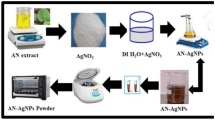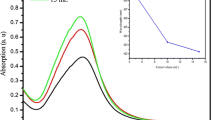Abstract
Green synthesis of nanomaterials is a current topic of extensive research and a number of green approaches as microorganisms and plant extracts have been explored as an alternative method for their synthesis. In this current work, an attempt has been made to observe the properties of silver oxide nanoparticles (Ag2O NPs), chemically prepared from silver ammonia complex by the traditional sol-gel method using citric acid, as well as from a green approach using aqueous leaf extract of Salix Integra. The synthesized Ag2O NPs were characterized by Powder X-ray Diffraction technique (PXRD), X-ray Photoelectron Spectroscopy (XPS), Scanning Electron Microscope (SEM), UV-Visible spectroscopy, Transmission electron microscope (TEM) and Fourier-Transform Infrared Spectroscopy (FT-IR). PXRD analysis showed that, the average particle size of the Ag2O NPs is 17.5 nm and 27.5 nm respectively from the chemical and the green approach. Green approach based Ag2O NPs and Salix Integra leaf extract are tested against gram-negative (E. coli) and gram-positive (S. aureus). In addition the Ag2O Nps were found to be effective against different microbial strains like M. tuberculosis H37Rv, M. Chelonae, M. Abscessus, and M. Fortuitum.
Graphical Abstract

The successful synthesis of Ag2O NPs by green and chemical approached and their use as a bactericidal agent against different microbes.
Highlights
-
Synthesis of Ag2O NP’s using green and chemical methods from Silver Ammonia Complex.
-
Characterization and comparative studies of the properties of the prepared Ag2O NP’s.
-
Studies for the bioapplication of Ag2O NP’s for antimicrobial studies.












Similar content being viewed by others
References
Vinay SP, Chandrasekhar N, Bhanu U, et al. (2019) Ixora coccinea extract-mediated green synthesis of silver nanoparticles: photodegradative and antimicrobial studies. Int J Biosensors Bioelectronics 5: https://doi.org/10.15406/ijbsbe.2019.05.00161
Ueda N, Maeda H, Hosono H, Kawazoe H (1998) Band-gap widening of CdO thin films. J Appl Phys 84:6174–6177. https://doi.org/10.1063/1.368933
Liu H, Zhang X, Li L, et al. (2007) Role of point defects in room-temperature ferromagnetism of Cr-doped ZnO. Appl Phys Lett 91: https://doi.org/10.1063/1.2772176
Maheshwaran G, Nivedhitha Bharathi A, Malai Selvi M, et al. (2020) Green synthesis of Silver oxide nanoparticles using Zephyranthes Rosea flower extract and evaluation of biological activities. J Environ Chem Eng 8:104137. https://doi.org/10.1016/j.jece.2020.104137
Khan I, Saeed K, Khan I (2019) Nanoparticles: Properties, applications and toxicities. Arab J Chem 12:908–931
Vaseashta A, Dimova-Malinovska D (2005) Nanostructured and nanoscale devices, sensors and detectors. In: Science and Technology of Advanced Materials. pp 312–318
Liang Z, Zhao J, Zhang Y (2010) Palladium-catalyzed regioselective oxidative coupling of indoles and one-pot synthesis of acetoxylated biindolyls. J Org Chem 75:170–177. https://doi.org/10.1021/jo902265s
Mabrook M, Hawkins P (2001) A rapidly-responding sensor for benzene, methanol and ethanol vapours based on films of titanium dioxide dispersed in a polymer operating at room temperature. Sensors and Actuators B-chemical - SENSOR ACTUATOR B-CHEM. 75:197–202. https://doi.org/10.1016/S0925-4005(01)00761-4
Ferreira FF, Tabacniks MH, Fantini MCA, et al. (1996) Electrochromic nickel oxide thin films deposited under different sputtering conditions. Solid State Ion 86–88:971–976. https://doi.org/10.1016/0167-2738(96)00236-6
Shume WM, Murthy HCA, Zereffa EA (2020) A Review on Synthesis and Characterization of Ag2O Nanoparticles for Photocatalytic Applications. J Chem 2020. https://doi.org/10.1155/2020/5039479
Seil JT, Webster TJ (2012) Antibacterial effect of zinc oxide nanoparticles combined with ultrasound. Nanotechnology 23: https://doi.org/10.1088/0957-4484/23/49/495101
Alivov YI, Kalinina EV, Cherenkov AE, et al (2003) Fabrication and characterization of n-ZnO/p-AlGaN heterojunction light-emitting diodes on 6H-SiC substrates. Appl Phys Lett 83:4719–4721. https://doi.org/10.1063/1.1632537
Lallo da Silva B, Caetano BL, Chiari-Andréo BG, et al (2019) Increased antibacterial activity of ZnO nanoparticles: Influence of size and surface modification. Colloids Surf B: Biointerfaces 177:440–447. https://doi.org/10.1016/j.colsurfb.2019.02.013
Iqbal S, Fakhar-e-Alam M, Akbar F, et al (2019) Application of silver oxide nanoparticles for the treatment of cancer. J Mol Struct 1189:203–209. https://doi.org/10.1016/j.molstruc.2019.04.041
Skiba MI, Vorobyova VI, Pivovarov A, Makarshenko NP (2020) Green synthesis of silver nanoparticles in the presence of polysaccharide: Optimization and characterization. J Nanomater 2020: https://doi.org/10.1155/2020/3051308
Panáček A, Kvítek L, Prucek R et al. (2006) Silver colloid nanoparticles: Synthesis, characterization, and their antibacterial activity. J Phys Chem B 110:16248–16253. https://doi.org/10.1021/jp063826h
Flores-Lopez NS, Cervantes-Chávez JA, Téllez de Jesús DG, et al. (2021) Bactericidal and fungicidal capacity of Ag2O/Ag nanoparticles synthesized with Aloe vera extract. J Environ Sci Health - Part A Toxic/Hazard Substances Environ Eng 56:762–768. https://doi.org/10.1080/10934529.2021.1925492
Singh J, Dutta T, Kim KH, et al. (2018) “Green” synthesis of metals and their oxide nanoparticles: Applications for environmental remediation. J Nanobiotechnology 16:1–24. https://doi.org/10.1186/s12951-018-0408-4
Fayyadh AA, Jaduaa Alzubaidy MH (2021) Green-synthesis of Ag2O nanoparticles for antimicrobial assays. J Mech Behav Mater 30:228–236. https://doi.org/10.1515/jmbm-2021-0024
Aravind M, Ahmad A, Ahmad I, et al. (2021) Critical green routing synthesis of silver NPs using jasmine flower extract for biological activities and photocatalytical degradation of methylene blue. J Environ Chem Eng 9:104877. https://doi.org/10.1016/j.jece.2020.104877
Thangavelu S, Dhandapani R, Arulprakasam A, et al. (2022) Isolation, Identification, Characterization, and Plasmid Profile of Urinary Tract Infectious Escherichia coli from Clinical Samples. Evidence-based Complementary and Alternative Med 2022: https://doi.org/10.1155/2022/7234586
Sharma AK, Dhasmana N, Dubey N, et al. (2017) Bacterial Virulence Factors: Secreted for Survival. Indian J Microbiol 57:1–10. https://doi.org/10.1007/s12088-016-0625-1
Behra PRK, Das S, Pettersson BMF, et al. (2019) Extended insight into the Mycobacterium chelonae-abscessus complex through whole genome sequencing of Mycobacterium salmoniphilum outbreak and Mycobacterium salmoniphilum-like strains. Scientific Rep 9. https://doi.org/10.1038/s41598-019-40922-x
Chandini KM, Al-Ostoot FH, Shehata EE, et al. (2021) Synthesis, crystal structure, Hirshfeld surface analysis, DFT calculations, 3D energy frameworks studies of Schiff base derivative 2,2′-((1Z,1′Z)-(1,2-phenylene bis(azanylylidene)) bis(methanylylidene)) diphenol. J Mol Struct 1244: https://doi.org/10.1016/j.molstruc.2021.130910
Elemike EE, Onwudiwe DC, Ekennia AC, et al. (2017) Green synthesis of Ag/Ag2O nanoparticles using aqueous leaf extract of Eupatorium odoratum and its antimicrobial and mosquito larvicidal activities. Molecules 22:1–15. https://doi.org/10.3390/molecules22050674
Lu PL, Liu YC, Toh HS, et al. (2012) Epidemiology and antimicrobial susceptibility profiles of Gram-negative bacteria causing urinary tract infections in the Asia-Pacific region: 2009–2010 results from the Study for Monitoring Antimicrobial Resistance Trends (SMART). Int J Antimicrob Agents 40: https://doi.org/10.1016/S0924-8579(12)70008-0
Ravichandran S, Paluri V, Kumar G, et al. (2016) A novel approach for the biosynthesis of silver oxide nanoparticles using aqueous leaf extract of Callistemon lanceolatus (Myrtaceae) and their therapeutic potential. J Exp Nanosci 11:445–458. https://doi.org/10.1080/17458080.2015.1077534
Wei W, Mao X, Ortiz LA, Sadoway DR (2011) Oriented silver oxide nanostructures synthesized through a template-free electrochemical route. J Mater Chem 21:432–438. https://doi.org/10.1039/c0jm02214d
Sun Q, Cai X, Li J, et al. (2014) Green synthesis of silver nanoparticles using tea leaf extract and evaluation of their stability and antibacterial activity. Colloids Surf A: Physicochemical Eng Asp 444:226–231. https://doi.org/10.1016/j.colsurfa.2013.12.065
Jain S, Mehata MS (2017) Medicinal plant leaf extract and pure flavonoid mediated green synthesis of silver nanoparticles and their enhanced antibacterial property. Sci Rep 7:1–14. https://doi.org/10.1038/s41598-017-15724-8
Armani MA, Abu-Taleb A, Remalli N, et al. (2016) Dragon’s blood-aided synthesis of Ag/Ag2O core/shell nanostructures and Ag/Ag2O decked multi-layered graphene for efficient As(III) uptake from water and antibacterial activity. RSC Adv 6:44145–44153. https://doi.org/10.1039/c6ra05061a
Albiter E, Valenzuela MA, Alfaro S, et al. (2015) Photocatalytic deposition of Ag nanoparticles on TiO2: Metal precursor effect on the structural and photoactivity properties. J Saudi Chem Soc 19:563–573. https://doi.org/10.1016/j.jscs.2015.05.009
Zielińska A, Kowalska E, Sobczak JW, et al. (2010) Silver-doped TiO2 prepared by microemulsion method: Surface properties, bio- and photoactivity. Sep Purif Technol 72:309–318. https://doi.org/10.1016/j.seppur.2010.03.002
Mani M, Harikrishnan R, Purushothaman P, et al. (2021) Systematic green synthesis of silver oxide nanoparticles for antimicrobial activity. Environ Res 202: https://doi.org/10.1016/j.envres.2021.111627
Chinnaraj S, Palani V, Maluventhen V, et al. (2022) Silver nanoparticle production mediated by Goniothalamus wightii extract: characterization and their potential biological applications. Particulate Sci Technol 0:1–15. https://doi.org/10.1080/02726351.2022.2123752
Mulvaney P (1996) Surface plasmon spectroscopy of nanosized metal particles. Langmuir 12:788–800. https://doi.org/10.1021/la9502711
Gole A, Dash C, Ramakrishnan V, et al. (2001) Pepsin-gold colloid conjugates: Preparation, characterization, and enzymatic activity. Langmuir 17:1674–1679. https://doi.org/10.1021/la001164w
Vinay SP, Udayabhanu, Nagaraju G, et al. (2019) Rauvolfia tetraphylla (Devil Pepper)-Mediated Green Synthesis of Ag Nanoparticles: Applications to Anticancer, Antioxidant and Antimitotic. J Clust Sci 30:1545–1564. https://doi.org/10.1007/s10876-019-01598-5
Allahverdiyev AM, Abamor ES, Bagirova M, Rafailovich M (2011) Antimicrobial effects of TiO(2) and Ag(2)O nanoparticles against drug-resistant bacteria and leishmania parasites. Future Microbiol 6:933–940
Neuberger T, Schöpf B, Hofmann H, et al. (2005) Superparamagnetic nanoparticles for biomedical applications: Possibilities and limitations of a new drug delivery system. In: J Magnetism Magnetic Mater 293:483–496
Vinay SP, Udayabhanu, Nagaraju G, et al. (2019) Novel Gomutra (cow urine) mediated synthesis of silver oxide nanoparticles and their enhanced photocatalytic, photoluminescence and antibacterial studies. J Sci: Adv Mater Devices 4:392–399. https://doi.org/10.1016/j.jsamd.2019.08.004
Kumar R, Ashfaq M, Verma N (2018) Synthesis of novel PVA–starch formulation-supported Cu–Zn nanoparticle carrying carbon nanofibers as a nanofertilizer: controlled release of micronutrients. J Mater Sci 53:7150–7164. https://doi.org/10.1007/s10853-018-2107-9
Kaviya S, Santhanalakshmi J, Viswanathan B, et al. (2011) Biosynthesis of silver nanoparticles using citrus sinensis peel extract and its antibacterial activity. Spectrochimica Acta - Part A: Mol Biomolecular Spectrosc 79:594–598. https://doi.org/10.1016/j.saa.2011.03.040
Indumathy R, Sreeram KJ, Sriranjani M, et al. (2010) Bifunctional role of Thiosalicylic Acid in the synthesis of Silver nanoparticles. Mater Sci Appl 01:272–278. https://doi.org/10.4236/msa.2010.15040
Hosseinpour-Mashkani SM, Ramezani M (2014) Silver and silver oxide nanoparticles: Synthesis and characterization by thermal decomposition. Mater Lett 130:259–262. https://doi.org/10.1016/j.matlet.2014.05.133
Urnukhsaikhan E, Bold BE, Gunbileg A, et al. (2021) Antibacterial activity and characteristics of silver nanoparticles biosynthesized from Carduus crispus. Sci Rep 11:1–12. https://doi.org/10.1038/s41598-021-00520-2
Sood R, Chopra DS (2018) Optimization of reaction conditions to fabricate Ocimum sanctum synthesized silver nanoparticles and its application to nano-gel systems for burn wounds. Mater Sci Eng C 92:575–589. https://doi.org/10.1016/j.msec.2018.06.070
Akhavan O, Ghaderi E (2010) Self-accumulated Ag nanoparticles on mesoporous TiO2 thin film with high bactericidal activities. Surf Coat Technol 204:3676–3683. https://doi.org/10.1016/j.surfcoat.2010.04.048
Calamak S, Aksoy EA, Ertas N, et al. (2015) Ag/silk fibroin nanofibers: Effect of fibroin morphology on Ag+ release and antibacterial activity. Eur Polym J 67:99–112. https://doi.org/10.1016/j.eurpolymj.2015.03.068
Guo Y, Wang S, Du H, et al. (2019) Silver Ion-Histidine Interplay Switches Peptide Hydrogel from Antiparallel to Parallel β-Assembly and Enables Controlled Antibacterial Activity. Biomacromolecules 20:558–565. https://doi.org/10.1021/acs.biomac.8b01480
Yin IX, Zhang J, Zhao IS, et al. (2020) The antibacterial mechanism of silver nanoparticles and its application in dentistry. Int J Nanomed 15:2555–2562. https://doi.org/10.2147/IJN.S246764
Xiu Z, Ma J, Alvarez PJJ (2011) Differential effect of common ligands and molecular oxygen on.pdf. Environ Sci Technol 45:9003–9008
Shanmuganathan R, MubarakAli D, Prabakar D, et al. (2018) An enhancement of antimicrobial efficacy of biogenic and ceftriaxone-conjugated silver nanoparticles: Green approach. Environ Sci Pollut Res 25:10362–10370. https://doi.org/10.1007/s11356-017-9367-9
Zhang J, Liu H, Ma Z (2016) Flower-like Ag2O/Bi2MoO6 p-n heterojunction with enhanced photocatalytic activity under visible light irradiation. J Mol Catal A: Chem 424:37–44. https://doi.org/10.1016/j.molcata.2016.08.009
Murugappan A, Sudarsan JS, Manoharan A (2006) Effects of using Lignite mine drainage for irrigation on soils - A case study of perumal tank command area in Tamilnadu State. J Ind Pollut Control 22:149–160
Acknowledgements
We gratefully acknowledge Malaviya National Institute of Technology Jaipur, India (all experimental work, TEM, SEM, and FT-IR studies) and Central University of Rajasthan, India (PXRD). We also acknowledge Dr. Sonkar S.K. (UV‐Vis study) for their invaluable aid. And our special thanks CSIR-Central Drug Research Institute, Lucknow, India (Antimicrobial activity test). We thankful to APX LABORATORIES Mumbai for antibacterial activity test.
Author information
Authors and Affiliations
Corresponding author
Ethics declarations
Conflict of interest
The authors declare no competing interests.
Additional information
Publisher’s note Springer Nature remains neutral with regard to jurisdictional claims in published maps and institutional affiliations.
Rights and permissions
Springer Nature or its licensor (e.g. a society or other partner) holds exclusive rights to this article under a publishing agreement with the author(s) or other rightsholder(s); author self-archiving of the accepted manuscript version of this article is solely governed by the terms of such publishing agreement and applicable law.
About this article
Cite this article
Patel, H., Joshi, J. Green and chemical approach for synthesis of Ag2O nanoparticles and their antimicrobial activity. J Sol-Gel Sci Technol 105, 814–826 (2023). https://doi.org/10.1007/s10971-023-06036-7
Received:
Accepted:
Published:
Issue Date:
DOI: https://doi.org/10.1007/s10971-023-06036-7




